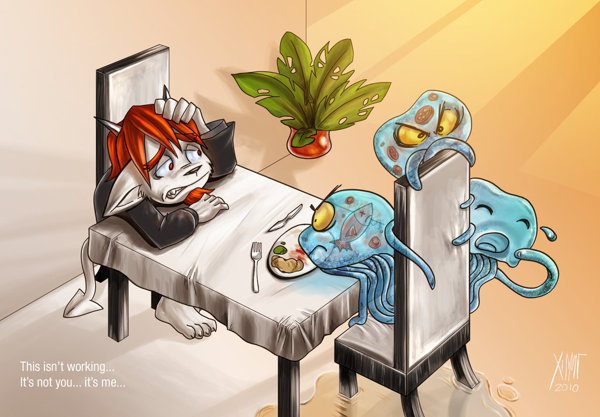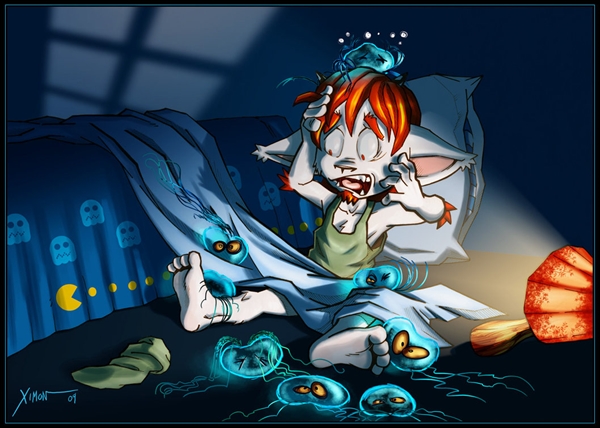Jellyfish Day 2024 is on Sunday, November 3, 2024: what is the life cycle of a jellyfish?
Sunday, November 3, 2024 is Jellyfish Day 2024. Jellyfish Day -5- by XimonR on deviantART Jellyfish Day -5- by XimonR
As an Amazon Associate I earn from qualifying purchases.

Jellyfish are dioecious; that is, they are either male or female. In most cases, to reproduce, both males and females release sperm and eggs into the surrounding water, where the (unprotected) eggs are fertilized and mature into new organisms. In a few species, the sperm swim into the mouth of the female, allowing the fertilization of the ova within the female's body. Moon jellies use a different process, in which the eggs become lodged in pits on the arms around the mouth, which form a temporary brood chamber to accommodate fertilization and early development.
After fertilization and initial growth, a larval form, called the planula, develops from the egg. The planula is a small larva covered with cilia. It settles onto a firm surface and develops into a polyp. The polyp is cup-shaped with tentacles surrounding a single orifice, resembling a tiny sea anemone. After an interval of growth, the polyp begins reproducing asexually by budding and, in the Scyphozoa, is called a segmenting polyp, or a scyphistoma. New scyphistomae may be produced by budding or new, immature jellies called ephyrae may be formed. A few jellyfish species are also capable of producing new medusae by budding directly from the medusan stage; such budding has been described from the tentacle bulbs, the manubrium (above the mouth), or the sexual organs of hydromedusae (each species buds only from one location). Fission of medusae (splitting in half) has been described for a few of species of hydromedusae.
Some of the most common and important jellyfish predators are other species of jellyfish, some of which are specialists in eating jellies. Other predators of jellyfish include tuna, shark, swordfish, and at least one species of Pacific salmon, as well as sea turtles. Sea birds sometimes pick symbiotic crustaceans from the bells of jellyfish near the surface of the sea, inevitably feeding also on the jellyfish hosts of these amphipods or young crabs and shrimp.
Jellyfish lifespans typically range from a few hours (in the case of some very small hydromedusae) to several months. The life span and maximum size of each species is unique. One unusual species is reported to live as long as 30 years and another species, Turritopsis dohrnii as T. nutricula, is said to be effectively immortal because of its ability to transform between medusa and polyp, thereby escaping death. Most of the large coastal jellyfish live about 2 to 6 months, during which they grow from a millimetre or two to many centimetres in diameter. They feed continuously and grow to adult size fairly rapidly. After reaching adult size (which varies by species), jellyfish spawn daily if there is enough food in the ecosystem. In most jellyfish species, spawning is controlled by light, so the entire population spawns at about the same time of day, often at either dusk or dawn.

How do Jellyfish procreate?
Here is the jellyfish life cycle.
In order for a jellyfish to be conceived, male jellyfish release sperm into the water. The sperm swims into the mouth of a female. From there, the sperm fertilize the eggs and eventually form an embryo - just like any typical process of reproduction.
After conception, there are five basic stages in the life cycle of a jellyfish.
1. A jellyfish embryo doesn't automatically turn into a baby jellyfish; instead, it becomes what's called a planula. A planula can swim, but not as gracefully as a jellyfish. It uses tiny cilia (hair-like extensions from it's body) to propel itself to the ocean floor, where it will attach itself to a hard, immobile object.
2. Once it's attached to a rock, shell, or other solid object, it begins to transform into a polyp. Polyps can survive for several years by catching and eating tiny sea creatures. These little polyps become capable of asexual reproduction - what that means is that growths from the walls of the polyp's body form and split off - and they've got all the makings to be their own separate polyp; this process is called budding.
3. As it grows, grooves in the polyp's body start to develop. When this happens, the polyp looks like a stack of discs on top of one another. Eventually, the grooves get so deep that they actually separate the body - and each piece is finally a baby jellyfish!
4. Baby jellyfish move through adolescence and become adults, just like every living creature does. As adults, they are capable of sexual reproduction and free to create tiny planula of their own.
Jellyfish are cnidarians, which means they're not actually a fish at all! 98% of a jellyfish's body is made of water - their thin (and sometimes transparent) skin holds a sticky, water-based goo inside. They have no bones or brains - but that doesn't stop their instinct for survival; some jellyfish stings can be fatal to humans.
5. Most jellyfish only live for about a year. Generally, those who live less than a year die at the flippers of hungry sea turtles. Once a jellyfish dies, it is either eaten by other sea creatures or decomposes on the ocean floor - either way, it's helping the sea's delicate ecosystem.
While jellyfish are simple creatures, their intricate process of procreation and birth are fascinating. Their short life span doesn't decrease their population, either - every day, new planula and polyp buds are developing on the ocean floor.
The above article was written by Angie Papple

How do Jellyfish live?
Jellyfish come in a big variety of colors. They are white, blue, pink, yellow, green, purple, red, orange, and striped. Each one of those colors represents the same thing. They are all bright colors and tell their enemies that they are dangerous fish.
The jellyfish’s tentacles look just like cooked noodles. The tentacles hang from underneath the jellyfish’s body. They can be as long as 1 cm to 120 feet long. That is longer than a basketball court!
Some jellyfish have more tentacles than they do body. Other jellyfish only have 1 cm long tentacles. The tentacles on a jellyfish are around the mouth. That is because when jellyfish grab their prey with their tentacles that sting them. After jellyfish sting their prey the jellyfish will pull their prey up to their mouth with their tentacles so that they can eat their food.
All jellyfish have a different amount of tentacles. They could have a few tentacles or as any as 800. That’s a lot! Every tentacle has a stinging cell. The stinging cell is located at the top of the tentacle. That is what makes the jellyfish able to sting their prey. When the jellyfish’s food swims by, it will touch the fish with its tentacles. That automatically kills the fish. When a jellyfish touches a person with their tentacles they will sting the person. If the jellyfish isn’t poisonous then the person won’t die. If the jellyfish is poisonous then the person might die.
Jellyfish can be as small as a grape or as big as a bed. It depends on what kind of jellyfish it is. If it is a box jellyfish and it is full grown it will be 4 meters long. If it is an umbrella jellyfish and it is full grown then it will only be about 1 inch long.
There are two layers in a jellyfish. There is an outer layer and an inner layer. The outer layer of the jellyfish is the protection. It protects jellyfish from their enemies. The inner layer is the lining of the jellyfish’s stomach. In between each layer is a gooey like material, which makes up the jellyfish.
Jellyfish have no skeleton. Jellyfish don’t have bones, which means they can move any part of their body any way they want.
Jellyfish come in three different shapes. They either come in a cup, bowl, or parachute shape. A cup shaped jellyfish is when the jelly like skin is frayed and is curved to make a cup. A bowl shaped jellyfish is when the jelly like skin is round and curves to make a bowl. Finally, a parachute shaped jellyfish is when the tentacles are a little bit longer than the body and fayed out around the body.
A jellyfish moves like an umbrella. The jelly like skin opens and lets water in. Then the jellyfish closes its jelly like skin and pushes all the water out. When the happens the jellyfish will shoot up just like a rocket ship.
Jellyfish tend to live for about one year. If jellyfish don’t live for about one year that is probably because another fish, turtle, or bird eats it. Another way they could die early is if they aren’t in salt water. Jellyfish have to be in salt water to be able to live.
Most sea animals are decreasing from the amount of pollution in the water. Jellyfish have been increasing for the past 10 years. That means that the pollution hasn’t harmed the jellyfish yet. We don’t know yet if pollution will affect the jellyfish later on.
Jellyfish have been on this earth for a very long time. They have been on for 450,000,000 years. That’s longer that dinosaurs!
When jellyfish get washed up to shore they can’t get back in the water. If you spot one laying on the beach remember where you saw it. Go back the next day. Then you will find that the jellyfish has melted. When jellyfish melt, all there will be is some of its skin surrounding the jellyfish. The inside will have evaporated.













